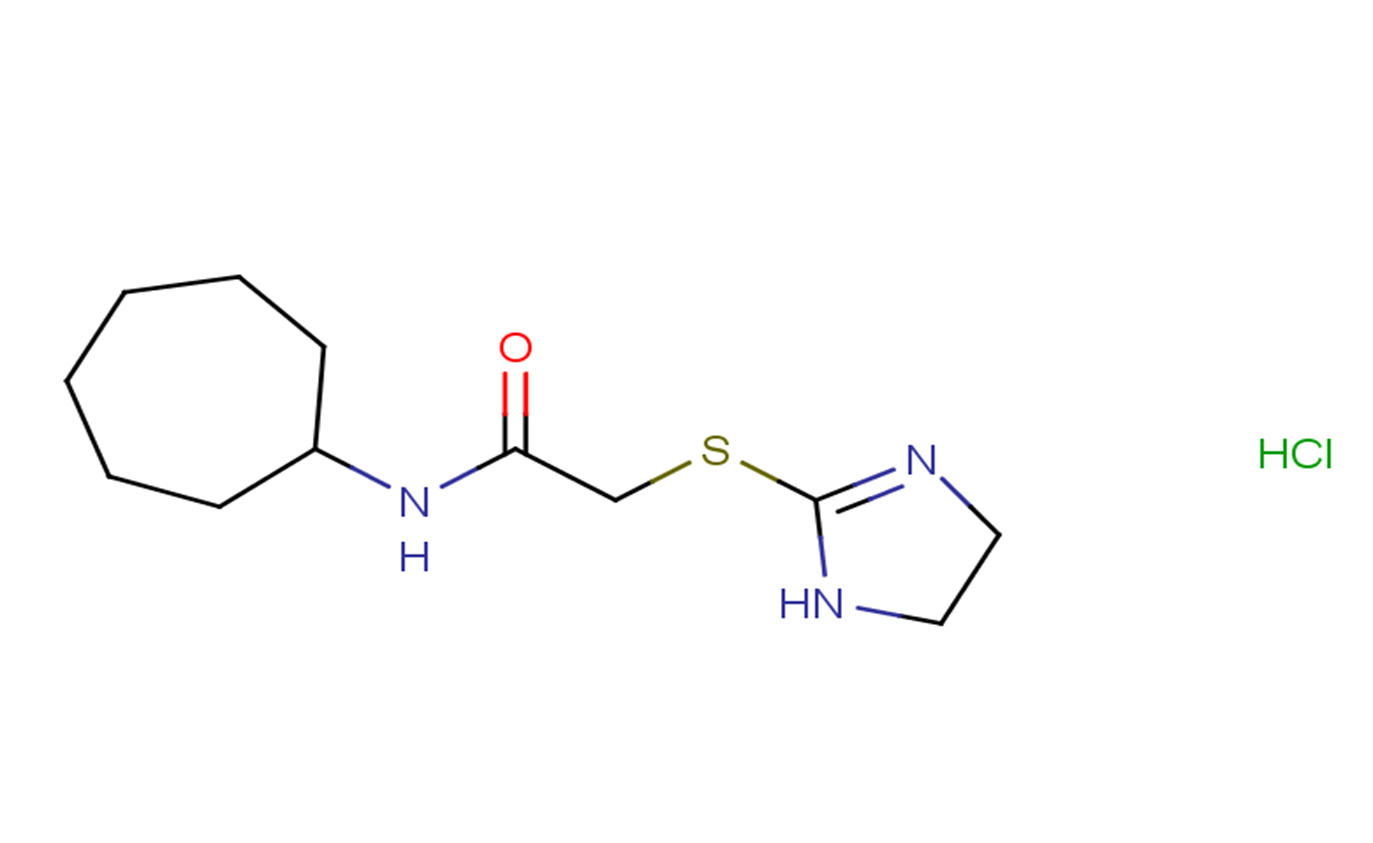Physicochemical Properties
| Molecular Formula | C12H22CLN3OS |
| Molecular Weight | 291.84 |
| Exact Mass | 291.117 |
| CAS # | 1803605-68-6 |
| PubChem CID | 91654402 |
| Appearance | White to off-white solid powder |
| Hydrogen Bond Donor Count | 3 |
| Hydrogen Bond Acceptor Count | 3 |
| Rotatable Bond Count | 4 |
| Heavy Atom Count | 18 |
| Complexity | 286 |
| Defined Atom Stereocenter Count | 0 |
| InChi Key | TZICOTBZKPHMMK-UHFFFAOYSA-N |
| InChi Code | InChI=1S/C12H21N3OS.ClH/c16-11(9-17-12-13-7-8-14-12)15-10-5-3-1-2-4-6-10;/h10H,1-9H2,(H,13,14)(H,15,16);1H |
| Chemical Name | N-cycloheptyl-2-(4,5-dihydro-1H-imidazol-2-ylsulfanyl)acetamide;hydrochloride |
| Synonyms | ICCB19 HClICCB 19 HClICCB-19 HClICCB-19hydrochlorideICCB 19hydrochlorideICCB19hydrochloride |
| HS Tariff Code | 2934.99.9001 |
| Storage |
Powder-20°C 3 years 4°C 2 years In solvent -80°C 6 months -20°C 1 month Note: Please store this product in a sealed and protected environment (e.g. under nitrogen), avoid exposure to moisture and light. |
| Shipping Condition | Room temperature (This product is stable at ambient temperature for a few days during ordinary shipping and time spent in Customs) |
Biological Activity
| ln Vitro | ICCB-19 hydrochloride has an IC50 of roughly 1 μM and inhibits both RIPK1-dependent cellular fluorescence (RDA) and cellular fluorescence caused by benezomib [1]. mTOR is not affected by ICCB-19 hydrochloride. Using ICCB-19 hydrochloride (10 μM) as a therapy, autophagy is stimulated via the following mechanisms. The number of DsRed-FYVE spots, levels, and inhibitory inhibitory activity of VPS34 can be increased by cells via the E3 ubiquitin that links cIAP1 and cIAP2 and the adaptor TRAF2[1]. The fast activation of RIPK1 in complex I caused by TNF is lessened by ICCB-19 hydrochloride (10 μM). TRADD, HOIP, and A20 recruitment are increased upon treatment with ICCB-19 hydrochloride, however beclin 1 K63 ubiquitination is not affected [1]. RIPK1 recruitment to complex I is increased[1]. |
| ln Vivo | Tradd is decreased by ICCB-19 hydrochloride?*? The TNF-induced factor target gene products NOS and COXII27, as well as the factor cytokine expression in cells stimulated by related molecular patterns, can all be downregulated by ICCB-19 hydrochloride [1]. |
| References |
[1]. Modulating TRADD to restore cellular homeostasis and inhibit apoptosis. Nature. 2020 Nov;587(7832):133-138. |
Solubility Data
| Solubility (In Vitro) |
H2O : ≥ 100 mg/mL (~342.65 mM) DMSO : ~83.33 mg/mL (~285.53 mM) |
| Solubility (In Vivo) |
Solubility in Formulation 1: ≥ 2.08 mg/mL (7.13 mM) (saturation unknown) in 10% DMSO + 40% PEG300 + 5% Tween80 + 45% Saline (add these co-solvents sequentially from left to right, and one by one), clear solution. For example, if 1 mL of working solution is to be prepared, you can add 100 μL of 20.8 mg/mL clear DMSO stock solution to 400 μL PEG300 and mix evenly; then add 50 μL Tween-80 to the above solution and mix evenly; then add 450 μL normal saline to adjust the volume to 1 mL. Preparation of saline: Dissolve 0.9 g of sodium chloride in 100 mL ddH₂ O to obtain a clear solution. Solubility in Formulation 2: ≥ 2.08 mg/mL (7.13 mM) (saturation unknown) in 10% DMSO + 90% (20% SBE-β-CD in Saline) (add these co-solvents sequentially from left to right, and one by one), clear solution. For example, if 1 mL of working solution is to be prepared, you can add 100 μL of 20.8 mg/mL clear DMSO stock solution to 900 μL of 20% SBE-β-CD physiological saline solution and mix evenly. Preparation of 20% SBE-β-CD in Saline (4°C,1 week): Dissolve 2 g SBE-β-CD in 10 mL saline to obtain a clear solution. Solubility in Formulation 3: ≥ 2.08 mg/mL (7.13 mM) (saturation unknown) in 10% DMSO + 90% Corn Oil (add these co-solvents sequentially from left to right, and one by one), clear solution. For example, if 1 mL of working solution is to be prepared, you can add 100 μL of 20.8 mg/mL clear DMSO stock solution to 900 μL of corn oil and mix evenly. (Please use freshly prepared in vivo formulations for optimal results.) |
| Preparing Stock Solutions | 1 mg | 5 mg | 10 mg | |
| 1 mM | 3.4265 mL | 17.1327 mL | 34.2654 mL | |
| 5 mM | 0.6853 mL | 3.4265 mL | 6.8531 mL | |
| 10 mM | 0.3427 mL | 1.7133 mL | 3.4265 mL |
